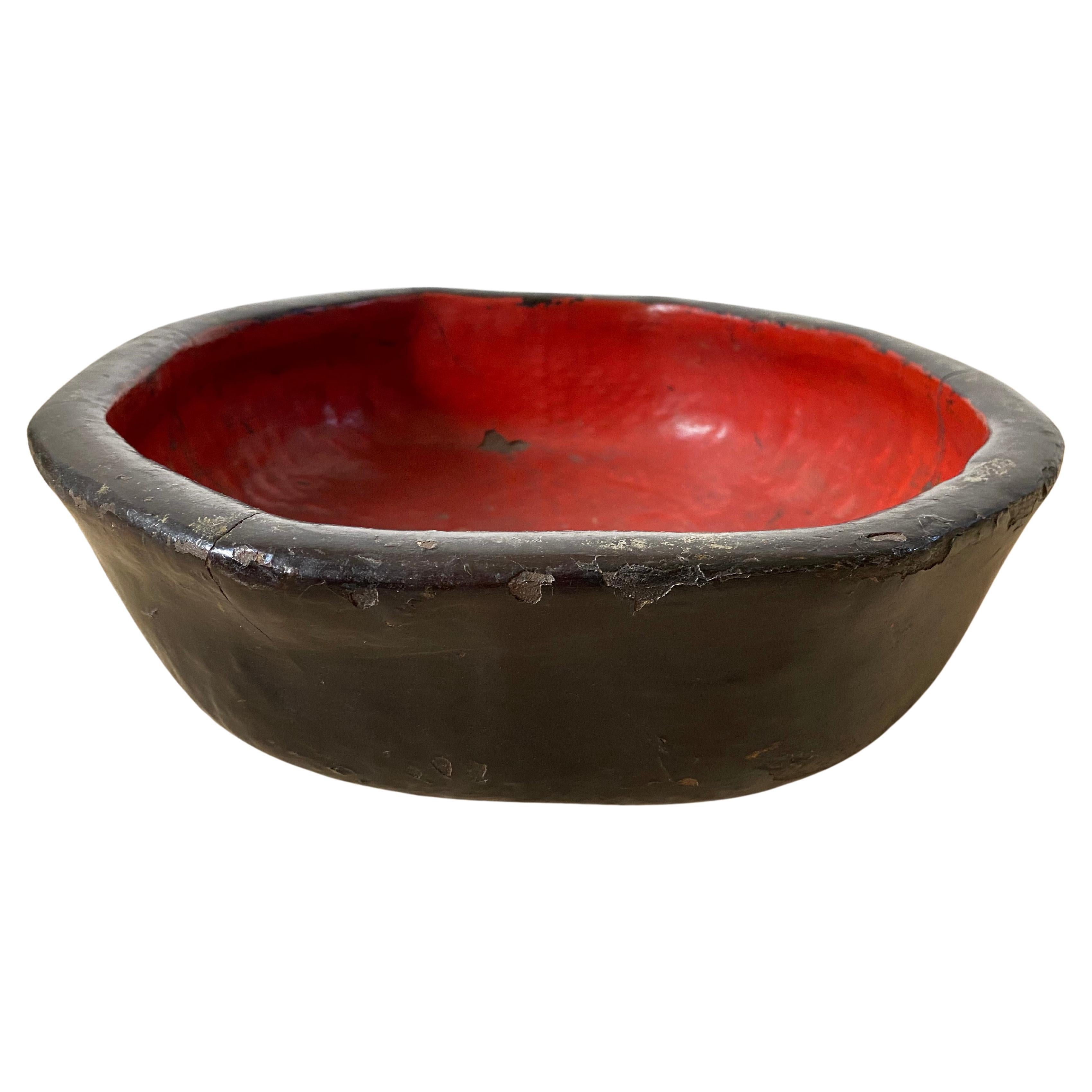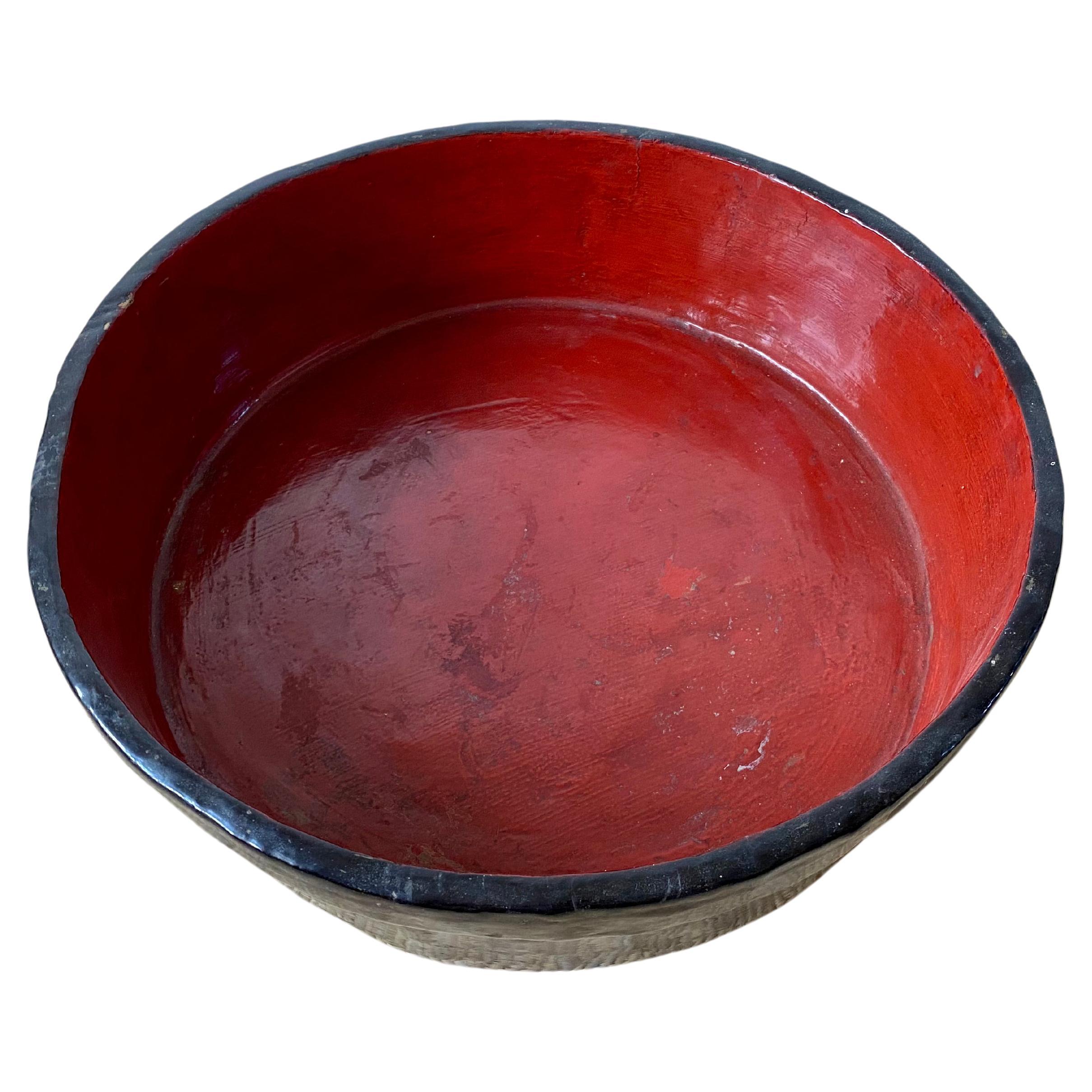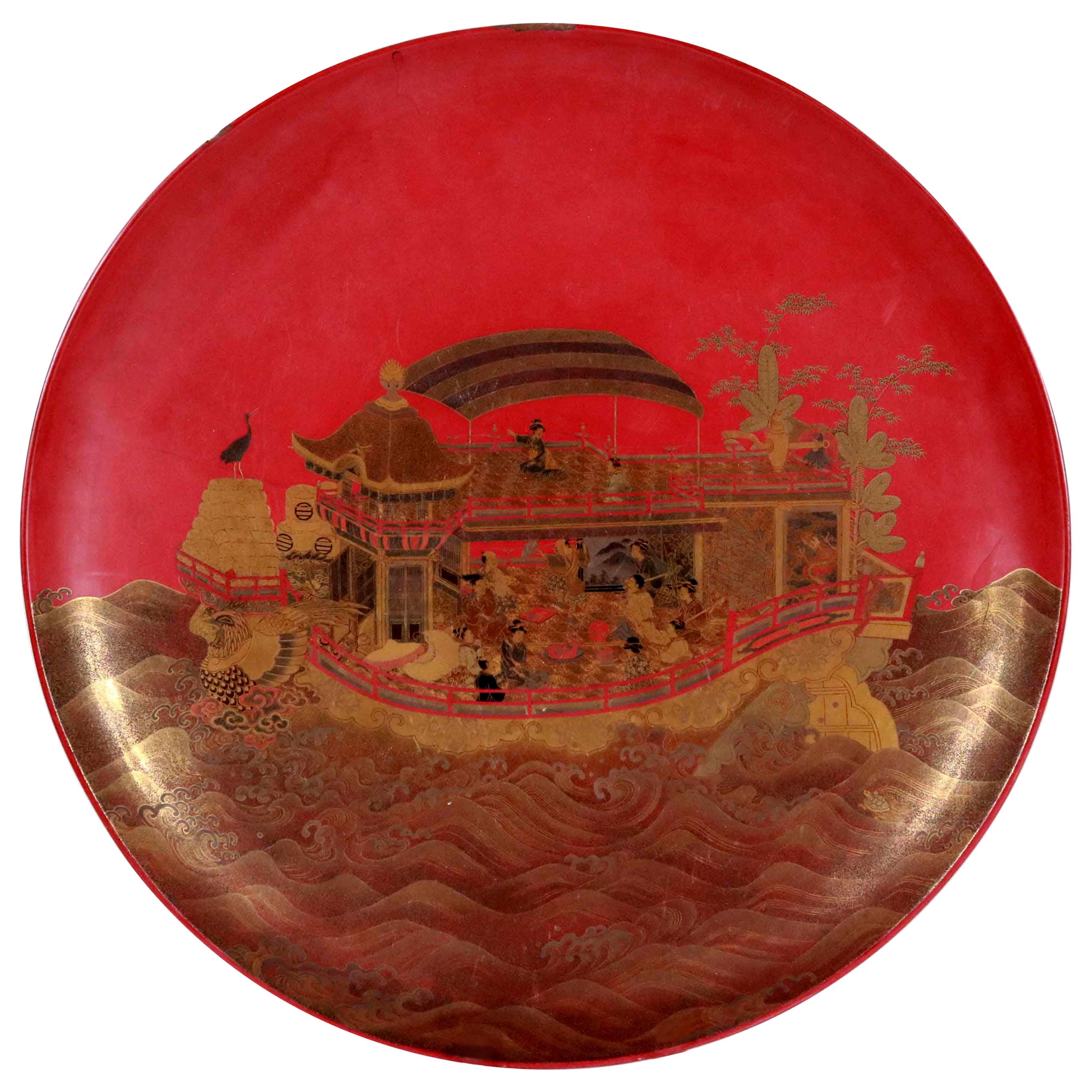Items Similar to Antique Japanese Lacquered Wood Wabi-Sabi Bowl
Want more images or videos?
Request additional images or videos from the seller
1 of 21
Antique Japanese Lacquered Wood Wabi-Sabi Bowl
About the Item
What can we say about this bowl? Perhaps we can start by describing the unique Japanese aesthetic concept of "Wabi-Sabi". In contrast to the western concept of beauty that is centered on "perfection", wabi-sabi strives to see beauty in transience and imperfection. Sometimes, it is an appreciation of the simplicity in an object, earthy, organic, natural, even decaying or broken, yet it still conveys a sense of beauty to a true connoisseur, who sees the world not only with eyes, but also with mind and a deep understanding and acceptance of the fragile and ephemeral nature of all things.
This wood bowl perfectly embodies this enduring Japanese concept. Made from an ancient piece of wood that is characterized by significant fissures, gaps and allover wormholes, the artist organically follow the essence of his material while fashioning it into a piece of art. In contrast to the organic essence of the material, the artist painstakingly put his human touch by creating a poetic inlaid image of an eggplant vine decorated with lacquer, gold Maki-e and Fundame. Three gold butterfly joints (knowns as Arikata in Japanese ) were used to stabilize the fissures, a practice in Japanese woodwork that make efforts to embrace the imperfection . There is a signature in gold kanji that reads "Yoshisai", the studio of Yoshi, but we couldn't identify the artist in our research. On the bottom of the bowl, the wholesomeness of the singular piece of wood is largely intact, with another old repair joint found.
The bowl, with its impressive organic form and artistic ornamentation, tells a story, and it is a philosophical one. It is about an ideal relationship between human and nature, about acceptance and humbleness, about a beauty that is more akin to poetry, about the consciousness of "the perfect imperfection".
Based on the patina and workmanship, we conservatively date the bowl to mid-19th century, Meiji period.
- Dimensions:Height: 6 in (15.24 cm)Width: 21.25 in (53.98 cm)Depth: 20 in (50.8 cm)
- Style:Japonisme (Of the Period)
- Materials and Techniques:
- Place of Origin:
- Period:
- Date of Manufacture:19th Century
- Condition:Repaired: An old historical join repair on the base as shown. Wear consistent with age and use. Minor losses. Natural wood with lots of characters as described. Small losses to the inlaid gold leaf, a fissure across the eggplants and some small losses of the inlay along the vine tendrils. All as shown in photos.
- Seller Location:Atlanta, GA
- Reference Number:1stDibs: LU945023412652
About the Seller
5.0
Platinum Seller
These expertly vetted sellers are 1stDibs' most experienced sellers and are rated highest by our customers.
Established in 2006
1stDibs seller since 2010
478 sales on 1stDibs
Typical response time: <1 hour
- ShippingRetrieving quote...Ships From: Atlanta, GA
- Return PolicyA return for this item may be initiated within 2 days of delivery.
More From This SellerView All
- Large Japanese Lacquer Plate with Elaborate Maki-e Design by KajikawaLocated in Atlanta, GAA large circular plate with a short stem base in Vermillion lacquer color. The surface was decorated with a stunning maki-e picture that depicts a...Category
Antique 19th Century Japanese Japonisme Lacquer
MaterialsLacquer
- Four Japanese Lacquered Sake Cups Meiji PeriodLocated in Atlanta, GAAn assemble of four lacquerware sake cups from Meiji period Japan circa late 19th century. The shadow cups on an elevated stem were used by the nobles during ...Category
Antique Late 19th Century Japanese Meiji Lacquer
MaterialsWood, Lacquer
- Japanese Lacquer Maki-e Plate of Takasago StoryLocated in Atlanta, GAA large circular plate with a short stem base in Vermillion lacquer color from Late Meiji Period circa end of 19th century to early 20th century. ...Category
Antique 19th Century Japanese Meiji Lacquer
MaterialsLacquer
- Japanese Lacquered Sake Drinking Set Meiji PeriodLocated in Atlanta, GAA Japanese lacquered Sake Drinking set circa late 19th century (end of Meiji period), The assemble consists of a red lacquer stand open frame support and a lid that encloses a storage space with black lacquered interior. The lid features a and a cup holder in the center and four heart shape cutouts on the corners. There are three maki-e decorated sake cups with gradual sizes. The cups showcase on the red background elaborate gold hiramaki-e paintings...Category
Antique Late 19th Century Japanese Meiji Lacquer
MaterialsWood, Lacquer
- Japanese Lacquer Maki-e Plate of Masked DancerLocated in Atlanta, GAA large circular plate with a short stem base in Vermillion lacquer color from Late Meiji Period circa end of 19th century to early 20th century. ...Category
Antique 19th Century Japanese Meiji Lacquer
MaterialsLacquer
- An Antique Japanese Lacquer Maki-e TrayLocated in Atlanta, GAA fan shape black lacquer tray from Japan circa 1910-30s, late Meiji to early Showa era. Elaborated decorated with a bundle of yomogi blossom in a very fine Maki-e technique using both gold and silver powders. There is a Japanese symbol on the top left, which represents yomogiu, stemming from yomogi (蓬), a wild plant that belongs to the chrysanthemum family and widely grown in Japan. This name yomogui is from a scene in the Tale of Genji...Category
Early 20th Century Japanese Japonisme Lacquer
MaterialsLacquer
You May Also Like
- Asian Japanese Red Lacquered Footed Bowl CenterpieceLocated in North Hollywood, CALarge vintage Japanese shallow footed bowl in red lacquer with gold calligraphy design. This beautiful lacquerware were made to serve foods during elaborate banquet. Great decorative...Category
Mid-20th Century Japanese Japonisme Decorative Bowls
MaterialsPaint, Lacquer
- Japanese Red & Black Lacquer Bowl, Early 20th CenturyLocated in Jimbaran, BaliA Japanese red & black lacquer bowl from the early 20th century. Its frame is crafted from woven rattan fibres and covered in multiple layers of lac...Category
Early 20th Century Japanese Other Decorative Bowls
MaterialsRattan, Lacquer
- 19th Century Lacquered Wood Basin or BowlLocated in New York, NYA large Chinese basin or bowl crafted out of peachwood, with red lacquer and forged bronze braces, circa 1880.Category
Antique 1880s Chinese Qing Decorative Bowls
MaterialsBrass
- Large Japanese Red & Black Lacquer Wooden Bowl, Early 20th CenturyLocated in Jimbaran, BaliA Japanese red & black lacquer wooden bowl from the early 20th century. It is carved from a block of what is likely to be fruit wood. The bowl has aged beautifully over the years wit...Category
Early 20th Century Japanese Meiji Decorative Bowls
MaterialsFruitwood, Lacquer
- Kanshitsu Bachi Lacquer Worker BowlLocated in Fukuoka, JPThis stunning lacquer worker bowl is a true work of art, expertly crafted using the Kanshitsu bachi technique. Kanshitsu bachi is a unique Japanese lacquerware...Category
20th Century Japanese Showa Lacquer
MaterialsWood, Lacquer
- Kanshitsu Bachi Stunning Color Lacquer BowlLocated in Fukuoka, JPA remarkable red-colored signed lacquer worker bowl crafted using the traditional Japanese lacquer technique Kanshitsu bachi. The Japanese lacquer technique, also known as urushi, is a time-honored process that involves coating objects with layers of sap derived from the lacquer tree. The lacquer dries to form a durable and glossy finish that is resistant to water, heat, and acids, making it a valuable addition to any collection. The stunning red color of this worker bowl is sure to make it a standout piece in any interior design, while its signed lacquer and skilled craftsmanship showcase its unique value as a collector's item. Investing in this Kanshitsu bachi lacquer worker bowl is a wise choice for both collectors and those looking for a unique and elegant item to add to their interior. Its rich cultural and artistic history, combined with its exceptional beauty and durability, makes it an investment that will be cherished for years to come. Don't miss this opportunity to own a piece of Japanese lacquer art and add a touch of sophistication to your home or collection. *Kanshitsu bachi. Kanshitsu is a Japanese lacquerware technique that involves the use of hemp cloth, linen or paper to create a base layer, which is then coated with multiple layers of lacquer. The result is a highly durable and decorative surface that can be shaped and carved into various forms. "Bachi" can refer to the wooden bowl used for mixing pigments in the process of making lacquerware, so it's possible that Kanshitsu bachi refers to an artist who specializes in lacquerware bowls...Category
Mid-20th Century Japanese Showa Lacquer
MaterialsWood, Lacquer
Recently Viewed
View AllMore Ways To Browse
Lacquered Wood
Mid Century Lacquer
Mid Century Lacquered
Lacquered Midcentury
Lacquered Base
Lacquer On Wood
Mid Century Wood And Lacquer
We Japanese
Japanese Wood
Japan Wood
Wood Furniture Japan
Wood Japanese Furniture
True Woods
Wood Used In Japanese Furniture
Japanese Art Wood
Patina Lacquer Furniture
Wabi Wabi
Wabi Sabi




